#Rajendravarman II
Text
A draft for historic greatness

This is the compact, unique five tower temple on the outskirts of the Big Angkor town that somehow is a draft for Angkor Wat.
Prasat Pre Rup, ប្រាសាទប្រែរូប, is a prelude construction to Angkor Wat, and is sometimes mistaken for the world famous symbol of Angkor and the Kingdom of Cambodia.
A true great god king
This was the state temple of King Rajendravarman II, built just south of East Mebon/East main reservoir and 6 km east of the site of Angkor Thom in 961CE. The king was one of the first true great kings of the Angkor Empire. He expanded the Khmer empire north to China, engulfing todays Laos and most of todays Thailand, and southeast into southern modern Viet Nam.
Prasat Pre Rup is built in mountain temple design with five towers, prangs, on top. They are reminiscent of the Mehru Mountains, the mythical mountainous home of the Hindu pantheon of gods. Inscription in the temple mentions that the five prangs were dedicated to Shiva, God of Time and Destruction (central tower and one of the surrounding towers), Vishnu, God of Preservation and protector of Good, Parvati, the consort of Shiva, and Lakshmi, the consort of Vishnu. King Rajendravarman II started his own version of architectural style with this prasat. It set the standard for the next century building in the Khmer Empire.
In front of the east entrance, Pre Rup has three large tower flanking on each side. On the top of the temple itself, you get some clean cut impressions of early Mebon Khmer style.

You also get a fantastic outlook view of Khmer Angkor culture landscape and nature. You will understand more of how this area provided the resources and inspiration of building a series of the largest human constructions before Europa entered the industrial revolution 800 years later.
The compact Angkor Wat
This temple was built over 200 years before the largest five-tower temple complex in the world, and is often mistaken, or used as an alternative to illustrate Angkor Wat itself. Simply because it is a compact version of the same design idea. It takes some time to get your head around how large the newer complex actually is.
Visiting this smaller and older temple is a way to understand the greatness of the Angkor Wat complex. Still Prasat Pre Rup is interesting to explore by itself.
Insiders tip
This temple are one of the sites in Angkor Part worth visit both to enjoy sunrise and sunset. Build in red sandstone, it gives a nice, warm glow during morning and afternoon sun. Even after rain. And it is tall enough with building details making shadow photos really interesting. A nice place to enjoy Khmer art and archaeology without the tourists crowds, too.

Pre Rup is still one of my favourite sights and I like to visit it wheneever I am in Angkor Archaeological park.
#prasat#pre#rup#angkortemples#angkor#top5#2011CE#red#sandstone#blue#rainyseason#world#culturalheritage#architecture#art#cambodia#buddhism#Angkor#Wat#Rajendravarman II#East#Mebon#Grand Circle#vietnam#champa
0 notes
Text
youtube
kingdom of Champa to the east (in the modern central Vietnam).[13]: 114–117
The son of Rajendravarman II, Jayavarman V, reigned from 968 to 1001. After he had established himself as the new king over the other princes, his rule was a largely peaceful period, marked by prosperity and a cultural flowering. He established a new capital slightly west of his father's and named it Jayendranagari; its state temple, Ta Keo, was to the south. At the court of Jayavarman V lived philosophers, scholars, and artists. New temples were also established: the most important of these are Banteay Srei, considered one of the most beautiful and artistic of Angkor, and Ta Keo, the first temple of Angkor built completely of sandstone.[13]: 117–118 [14]: 367
The pyramid of Koh Ker. Koh Ker was briefly the capital of the Khmer Empire
A decade of conflict followed the death of Jayavarman V. Three kings reigned simultaneously as antagonists until Suryavarman I (reigned 1006–1050) gained the throne.[13]: 134–135 Suryavarman I established diplomatic relations with the Chola dynasty of south India.[27] Suryavarman I sent a chariot as a present to the Chola Emperor Rajaraja Chola I.[28] His rule was marked by repeated attempts by his opponents to overthrow him and by military conquests. Suryavarman was successful in taking control of the Khmer capital city of Angkor Wat.[29]
At the same time, Angkor Wat came into conflict with the Tambralinga kingdom of the Malay peninsula.[29][30] In other words, there was a three-way conflict in mainland Southeast Asia. After surviving several invasions from his enemies, Suryavarman requested aid from the powerful Chola Emperor Rajendra Chola I of the Chola dynasty against the Tambralinga kingdom.[29][31][32] After learning of Suryavarman's alliance with Rajendra Chola, the Tambralinga kingdom requested aid from the Srivijaya King Sangrama Vijayatungavarman.[29][30]
This eventually led to the Chola Empire coming into conflict with the Srivijaya Empire. The war ended with a victory for the Chola dynasty and of the Khmer Empire, and major losses for the Srivijaya Empire and the Tambralinga kingdom.[29][30] This alliance also had religious nuance, since both Chola and Khmer empire were Hindu Shaivite, while Tambralinga and Srivijaya were Mahayana Buddhist. There is some indication that before or after these incidents Suryavarman I sent a gift, a chariot, to Rajendra Chola I to possibly facilitate trade or an alliance.[13]: 136 [33] Suryavarman I's wife was Viralakshmi, and following his death in 1050, he was succeeded by Udayadityavarman II, who built the Baphuon and West Baray.[13]: 135, 137–138 In 1074, conflict arose between Harshavarman III and the Champa King Harivarman IV.[13]: 152
Golden age of Khmer civilization[edit]
King Suryavarman II
Angkor Wat
Suryavarman II – Angkor Wat[edit]
Further information: Khmer–Cham wars
The 12th century was a time of conflict and brutal power struggles. Under Suryavarman II (reigned 1113–1150) the kingdom united internally[16]: 113 and the large temple of Angkor was built in a period of 37 years: Angkor Wat, dedicated to the god Vishnu.
In the east, his campaigns against Champa, and Dai Viet, were unsuccessful,[16]: 114 though he sacked Vijaya in 1145 and deposed Jaya Indravarman III.[34]: 75–76 The Khmers occupied Vijaya until 1149, when they were driven out by Jaya Harivarman I.[13]: 160 Suryavarman II sent a mission to the Chola dynasty of south India and presented a precious stone to the Chola emperor Kulottunga Chola I in 1114.[35][36]
Another period followed in which kings reigned briefly and were violently overthrown by their successors. Finally, in 1177 the capital was raided and looted in a naval battle on the Tonlé Sap lake by a Cham fleet under Jaya Indravarman IV, and Tribhuvanadityavarman was killed.[13]: 164 [34]: 78
0 notes
Text
Et utkast til en gigantisk verdensarv

Dette er en av mine absolutt favoritter i Angkor-parken. Prasat Pre Rup, ប្រាសាទប្រែរូប, er et kompakt, femtårns tempel av baketopptypen. Det ligger 6 kilometer unna det som seinere er kjent som Angkor Thom, storbyen Angkor.
Pre Rup regnes også som et tidlig utkast av det som seinere blei det største religiøse tempelanlegget i verden: Angkor Wat. Det er så snarlik at bilder av Pre Rup av og til brukes som reklamefoto for besøk til Angkor Wat.
En av de første store Khmer-gudekongene
Dette tempelet var det offisielle statstempelet til kong Rajendravarman II. Det er bygd i 961 rett sør for det store østlige vannmagasinet, East Mebon. I dag er tempelet 6 kilometer øst for Angkor Wat og Angkor Thom, bygd 250 år seinere.
Rajendravarman II var en av de store gudekongene av Khmer-imperiet. Han utvidet riket opp til dagens Kina, områder som i dag er Laos og det meste av Thailand. Sørøstover utvidet han riket til dagens sør-vietnam, om lag fra dagens Mekong-delta og opp til området rundt Da Nang.
Til Shivas ære
Prasat Pre Rup er bygd som en kopi av de hinduistiske hellige Mehru-fjellene og deres fem topper, gudenes hjem i pantheon-varianten av hinduisme. Det er viet til Shiva, som er skaper- og dødsgud i en variant, og den store tids- og ødeleggeren i treenighets-varianten av hinduisme.

De fem hellige tårnene, prang, på toppen har det sentrale og et av de andre viet til Shiva. De tre andre er viet til Vishnu, guddom for vern, bevaring og alt som er godt, Parvati, Shivas kvinnelige partner, og Lakshmi, den kvinnelige partneren til Vishnu.
Starten på østlig Mebon-perioden
Kong Rajendravarman II utviklet sin egen versjon av khmer arkitektur med dette tempelet. Denne østlige Mebon-stilen var dominant bygningsstil i Khmer-riket for de neste drøyt hundre årene.
Foran øst-inngangen, hovedinngangen til Pre Rup, er det tre store tårn, pranger, til venstre for inngangen, speilet av to tårn til høyre for inngangen. Det er rom for et tredje tårn der, men det er usikkert om det i det hele tatt ble bygd, eller om det ble demontert.

Tempelet har en grunnflate på 87 ganger 77 meter, og det er bygd i tre etasjer. Topplattformen med de fem tårnene er 35 meter i kvadrat. Både statuer, utskjæringer og alterdesign er veldig typisk for arkitekturstilen som ble introdusert. Men nesten vel så imponerende er utsikten til det levende og historiske kulturlandskapet og naturen som både var og er særpreget for Angkor.
Det er lettere å forstå hvordan landskap inspirerete og ga næring til å bygge en sivilisasjon og og et enormt rike som varte i 500 år. Og hvordan denne sivilisasjonen også bygde noen av de største konstruksjonene og unike bygg i menneskets verdenshistorie. Noen av dem ble ikke overgått før den industrielle revolusjonen startet i Europa 800 år seinere.
Besøkstips
Pre Rup ble bygd 200 år før det største fem-tårns tempelkomplekset som fortsatt står ble bygd. Og det fungerer fortsatt som en nøkkel til å forstå det mye større og mer komplekse Angkor Wat. Men Pre Rup er likevel verdt et besøk og undersøke i seg sjøl.
En av mulighetene i å besøke Pre Rup, er at både tempel og område rundt egner seg for soloppgang og solnedgangsbesøk. Den røde sandsteinen som dominerer materialene i tempelet gir en varm, intens glød når skrå solstråler treffer konstruksjonen når sola er nær horisonten. De tydelige tårn- og statueelementene gir gode kontraster og spennende siluetter. Og siden det er litt mindre og et stykke unna de store templene kan dette nytes uten altfor store horder av turister.
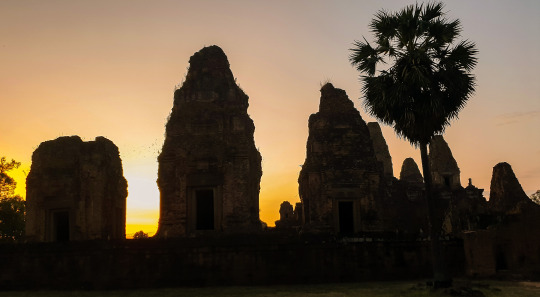
Om du nå vil nyte dette i rolig sittende i en stol med noe å drikke, som de lokale selgerne gjerne bidrar med. Eller vil vandre litt rundt og fotografere.
For den som vil oppleve dette fra sykkelsetet, ligger tempelet rundt 35 minutter sykling i moderat tempo unna Siem Reap sentrum og Gamlemarked. Det er både vanlig asfaltert vei, og litt tøffere og stemningsfulle sykkelstier til og rundt tempelet. På vei mellom Siem Reap og Pre Rup ligger Sray Srah-bassenget, og rundt det er det et stort utvalg av khmer gatemat og små restauranter for frokost, lunsj eller middag.
Pre Rup var det fjerde tempelet jeg besøkte i Angkor Archeological park tilbake i 2011. Det er fortsatt en favoritt.
#prasat#pre#rup#angkortemples#angkor#top5#2011CE#red#sandstone#blue#rainyseason#world#culturalheritage#khmer#kambodsja#khmerkultur#khmerkjøkken#buddhisme#drikke#opplevkambodsja#cambodia#hinduisme#Østlig#Mebon#arkitektur#design#khmer rike#gudekonge#Laos#Kina
0 notes
Photo
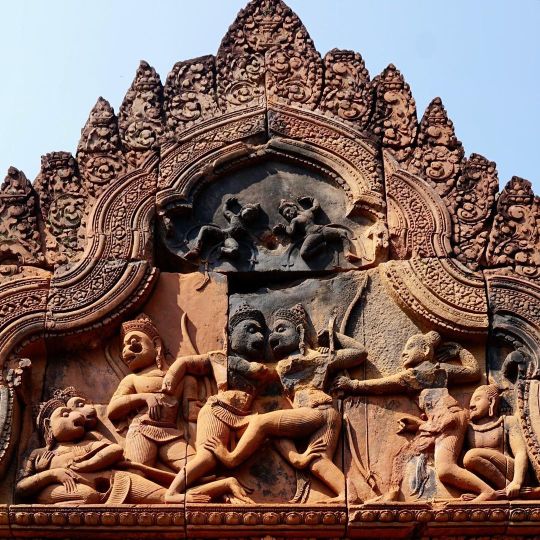
Banteay Srei - 967 CE during the reign of Rajendravarman II by Yajñavarāha - Angkor - 16 January 2023 (at Banteay Srei Temple ប្រាសាទបន្ទាយស្រី) https://www.instagram.com/p/CpUoTo_LSv0/?igshid=NGJjMDIxMWI=
0 notes
Text
Sras Srang was dug in the mid-10th century, by initiative of Kavindrarimathana, Buddhist minister of Rajendravarman II. It was modified around the year 1200 by Jayavarman VII, who added the laterite landing-stage at its western side, probably because the East Baray had been overwhelmed by sediment and had begun malfunctioning.
youtube
0 notes
Photo
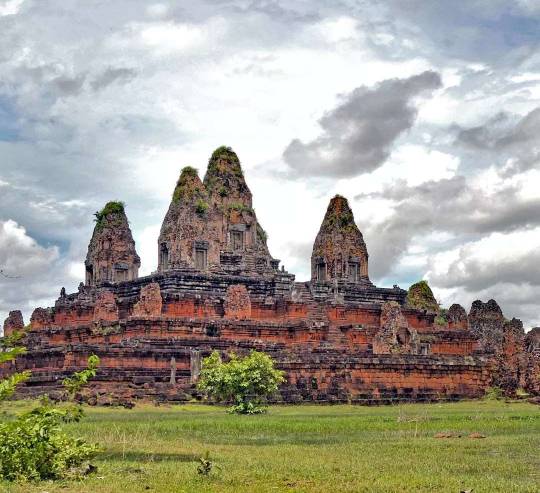
The compact, unique five tower temple on the outskirts of Angkor town Pre Rup is a prelude temple to Angkor Wat, and often mistaken for the world famous symbol of Angkor and the Kingdom of Cambodia. It was the state temple of King Rajendravarman II, built just south of East Mebon and 6 km east of Angkor Thom in 961CE. The king was one of the first true great kings of the Angkor Empire. He expanded the empire north to China, engulfing Laos and most of Thailand, and south into southern Viet Nam. Prasat Pre RupIt is built in mountain temple design with five towers, prangs, on top, reminiscent of the Mehru Mountain home of the hindu pantheon of gods. Inscription in the temple mentions that the five prangs were dedicated to Shiva (central tower and one of the surrounding towers), Vishnu, Parvati (the consort of Shiva) and Lakshmi (the consort of Vishnu). In front of the east entrance, it has three larges flower flanking on each side. On the top, you get some clean cut impressions of early mebon khmer style. But, you also get a fantastic outlook view of khmer angkor culture landscape and nature. The temple was built over 200 years before the largest five-tower temple complex in the world, and is often mistaken, or used as an alternative to illustrate Angkor Wat simply because it a compact version of the same design idea. And, it takes some time to get your head around how large the newer complex actually is. Pre Rup is still one of my favourite sights in Angkor Archeological park. https://www.renown-travel.com/cambodia/angkor/pre-rup.html #prasat #pre #rup #angkortemples #angkor #top5 #2011CE #red #sandstone #blue #rainyseason #world #culturalheritage (ved ប្រាសាទប្រែរូប- Pre Rub Temple) https://www.instagram.com/p/CTcdhWsJDBo/?utm_medium=tumblr
#prasat#pre#rup#angkortemples#angkor#top5#2011ce#red#sandstone#blue#rainyseason#world#culturalheritage
28 notes
·
View notes
Photo
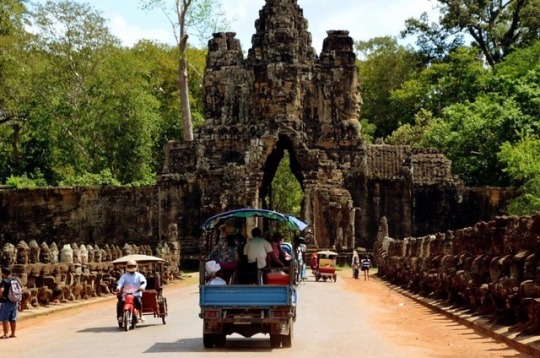
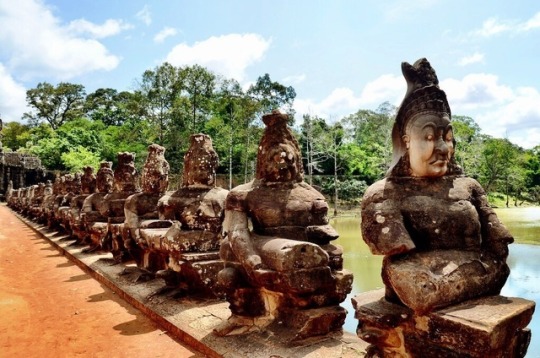
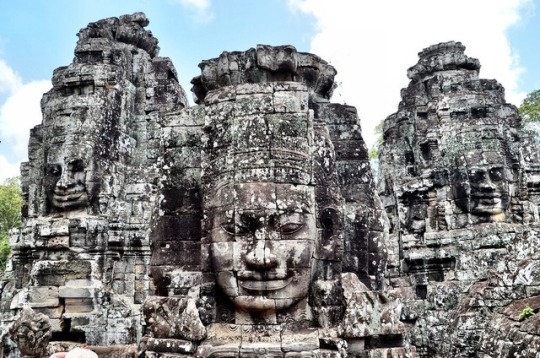

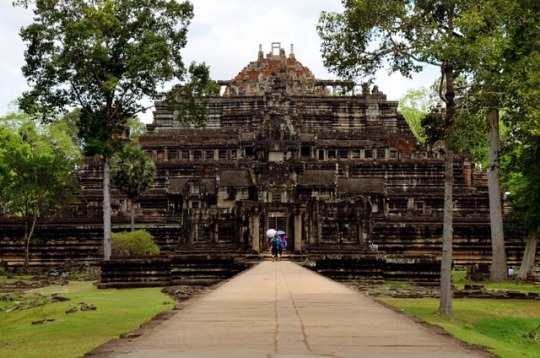
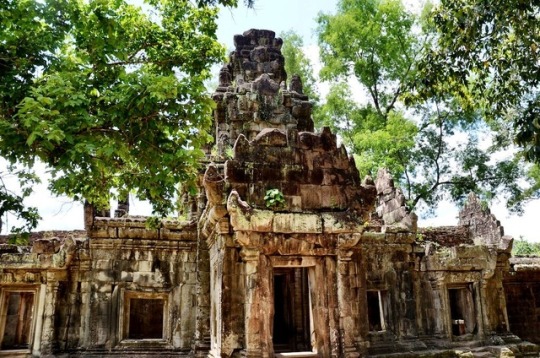
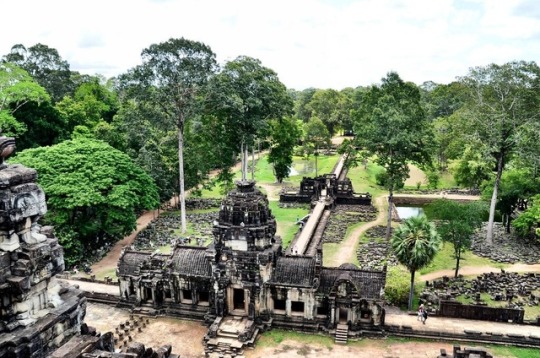

ANGKOR THOM TAPINAĞI / KAMBOÇYA
Angkor Thom, Kmerce’de “Büyük Şehir” anlamına geliyor. Bir Budist tapınağı olarak,12.yy Kmer İmparatorluğu döneminde dini ve idari merkez olarak kullanılmış. İnşası iki farklı imparator dönemi kadar sürdüğü için Baphuon ve Banyon iki farklı merkez olarak kullanılmış. Angkor Thom Tapınağı oldukça geniş bir alan üzerine inşa edilmiş. Cüzzamlı Kral Terası (Terrace of the Leper King), Filler Terası (Terrace of the Elephants), Bayon Tapınağı, Phimeanakas Tapınağı ve Baphuon‘u kapsayan devasa bir kompleks.
Bayon Tapınağı: Toplamda 216 adet devasa heykelden oluşuyor.Taşa oyularak yapılmış çeşitli büyüklükteki bu yüzlerin neyi temsil ettiği konusunda net bir bilgi yok.Nirvana’ya ulaşmanın mutlu hali olduğunu söyleyen de var, Bayon’u inşa ettiren Kral VII Jayavarman‘a benzediğini söyleyen de.
Baphuon Tapınağı : Baphuon; Kmer İmparatorluğunun 12.yy’daki başkenti olarak hizmet etmiş. Hindu tanrılarının efsanevi evi olan Meru Dağı’nı sembolize ediyormuş. Yüzyıllar boyunca sayısız yıkım ve restorasyondan geçmiş. Ana yapılarını ve genel hatları ayakta tutmayı başarsalar da, aynı şeyi duvarlardaki detaylar için söylemek zor.
Fil Terası : Fil Terası’nın, Kral VII Jayavarman tarafından halka hitap etmek için kullanıldığına inanılıyor. Terasın duvarlarını at ve maymun figürlerinin yanı sıra yüzlerce fil figürü de süslüyor. Sahip olduğu büyük fil şekilleri, terasa karakteristik özelliğini vermiş. Terasın üzerindeki bir heykelin “Cüzzamlı Kral”a ait olduğunu düşünen de var, Hinduların yeraltı tanrısının heykeli olduğunu düşünen de. Angkor Thom Tapınağı’nın en orijinal bölümlerinden biri.
Phimeanakas Tapınağı : Bir Hindu tapınağı olarak Kral II Rajendravarman döneminde inşa edilmiş. Farklı bir piramit şekline sahip. Tapınağın merdivenleri hala restore edilmemiş. Tapınağı korusun diye köşelere dikilen aslan heykellerinin bazılarının sadece bazı parçaları kalmış. Aslında bu piramit şeklindeki tapınağın yanında, ahşap bir Kraliyet Sarayı da varmış. Başkent Phnom Penh olunca bu sarayı yerle bir etmişler.
Cüzzamlı Kral Terası : Bu yapı 12.yy’da Kral VII Jayavarman döneminde inşa edilmiş. Terasa adını veren “Leper Kralı / Cüzamlı Kral”ın kim olduğu hala gizemini koruyormuş. Cüzamlı Kral Terası denmesine, üzerindeki heykelin renginin soluk ve tarihteki cüzamlı bir krala benzerliğinin neden olduğu söyleniyor.
https://www.renkliyolculuk.com/angkor-thom-tapinagi-kambocya/
PHOTOS BY https://landlopers.com/ Matt Long
#angkor thom#kamboçya#cambodia#bayon tapınağı#bayon temple#baphuon tapınağı#baphuon temple#cüzzamlı kral terası#terrace of the leper king#filler terası#terrace of the elephants#phimeanakas tapınağı#phimeanakas temple#güneydoğu asya#southeast asia#seyahat#travel#inanç#belief#tarih#history#gezi#trip#keşfet#discover#landlopers.com#renkliyolculuk.com
11 notes
·
View notes
Photo
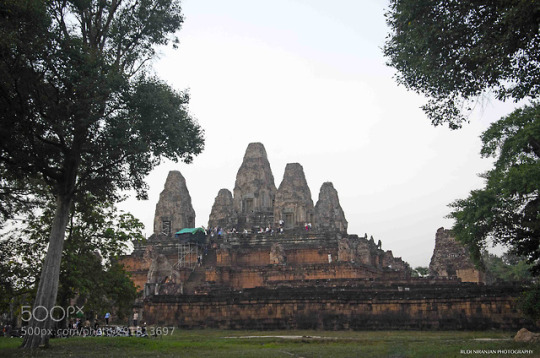
State Temple of Khmer King Rajendravarman II... by Stills_Studio
#Cambodia#Nikon D7000#Nikkor#Siem Reap#South East Asia#Landscape#City#Travel Photography#Photographe_
6 notes
·
View notes
Photo
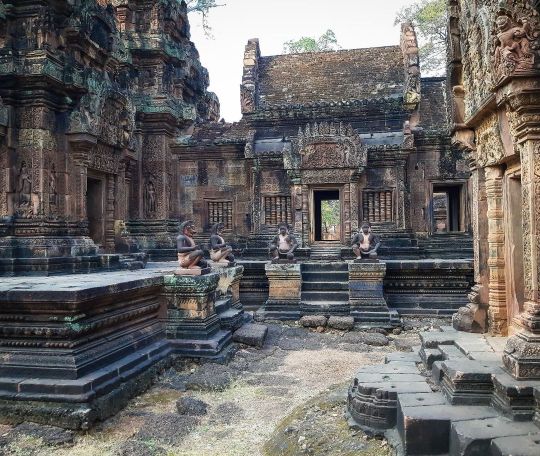
Time is passing by fast - one year ago visiting the temples of Angkor in Cambodia. 🇰🇭📸😊🙏🧡 Prasat Banteay Srei - The Citadel of the women is an exquisite miniature; a fairy palace in the heart of an immense and mysterious forest. ~~~~ Banteay Srei or Banteay Srey (Khmer: ប្រាសាទបន្ទាយស្រី) is a 10th-century Cambodian temple dedicated to the Hindu god Shiva. Located in the area of Angkor, it lies near the hill of Phnom Dei, 25 km (16 mi) north-east of the main group of temples that once belonged to the medieval capitals of Yasodharapura and Angkor Thom. Banteay Srei is built largely of red sandstone, a medium that lends itself to the elaborate decorative wall carvings which are still observable today. The buildings themselves are miniature in scale, unusually so when measured by the standards of Angkorian construction. These factors have made the temple extremely popular with tourists, and have led to its being widely praised as a "precious gem", or the "jewel of Khmer art." Consecrated on 22 April 967 A.D., Bantãy Srĕi was the only major temple at Angkor not built by a monarch; its construction is credited to the courtiers named Vishnukumara and Yajnavaraha Yajñavarāha (modern Khmer: យជ្ញវរាហៈ), who served as a counsellor to king Rajendravarman II (modern Khmer: ព្រះបាទរាជេន្រ្ទវរ្ម័ន). The foundational stela says that Yajnavaraha, grandson of king Harsavarman I, was a scholar and philanthropist who helped those who suffered from illness, injustice, or poverty. His pupil was the future king Jayavarman V (r. 968- ca. 1001). Originally, the temple was surrounded by a town called Īśvarapura. . . #asianwanderlust #discoverasia #asiatour #asiatravel #loveasia #seasia #seasiatravel #southeastasiatravel #southeastasiatrip #travelinasia #travelsoutheastasia #visitseasia #visitasia #beautifulcambodia #bestofcambodia #cambodge #cambodiaphotos #cambodiatourism #cambodiatravel #cambodiatrip #cambodia🇰🇭 #camboya #explorecambodia #ig_cambodia #igerscambodia #kambodscha #kingdomofwonder #travelcambodia #visitcambodia #worldheritagesite (at Banteay Srei) https://www.instagram.com/p/CVx0mBqMTJV/?utm_medium=tumblr
#asianwanderlust#discoverasia#asiatour#asiatravel#loveasia#seasia#seasiatravel#southeastasiatravel#southeastasiatrip#travelinasia#travelsoutheastasia#visitseasia#visitasia#beautifulcambodia#bestofcambodia#cambodge#cambodiaphotos#cambodiatourism#cambodiatravel#cambodiatrip#cambodia🇰🇭#camboya#explorecambodia#ig_cambodia#igerscambodia#kambodscha#kingdomofwonder#travelcambodia#visitcambodia#worldheritagesite
0 notes
Text
Top Attractions to Visit in Angkor, Cambodia
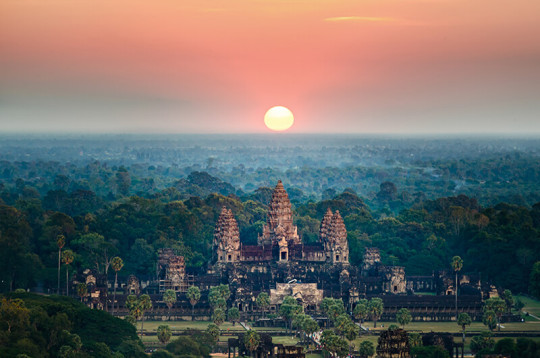
Angkor in Cambodia, also regarded as the centre of the Khmer empire, is a beautiful destination with a plethora of amazing temples and buildings. Amidst this immensely packed tourist spot, it is still breathtaking to see the ruins and temples - that redefine the beauty of this place once again!
Here are a few favourite tourist destinations in Angkor that are a must-see! You must not miss these places during your Angkor holiday.
Elephant terrace
This 1000-feet terrace of elephants is one of the most popular tourist spots that address various public ceremonies and royal events. It is one of the most elegant views of this place, and you would hardly find time over here without a bubbling crowd. Thus, ensure adding this spot in your holiday packages to Angkor.
Preah Khan
If you love visiting temples, this is one of the most popular attractions to try out! A large Buddhist University with one thousand teachers out here is something you would love to watch out! Although this place is left unrestored, with mosses and stones scattered all around, yet it still brings up that nostalgic feel of the palace of Yasovarman II and Tribhuvanadityavarman, along with the historical battle that was addressed here once upon a time.
Pre Rup
It lies about 2000 feet south of the East Baray. Rajendravarman, after taking over the throne, coined this place as the capital of Angkor. The steep steps of this place seem no less than a pyramid.
Sailani Tours N Travels is one of the best tours and travels websites offering lucrative deals to make your vacation the best! We ensure that you have the utmost comfort throughout the journey and the best of the experiences with us at the most competitive holiday packages!
0 notes
Photo
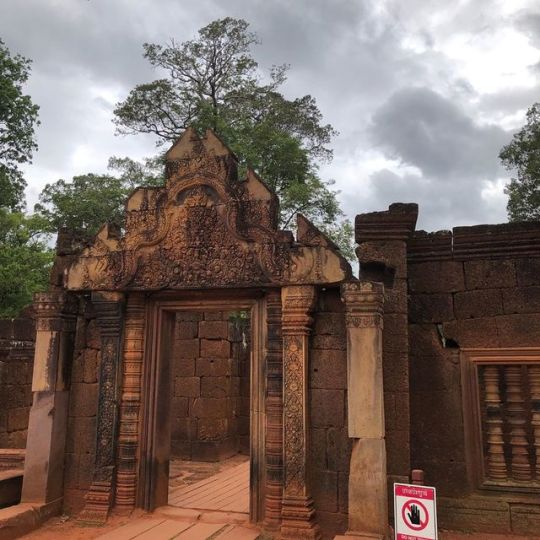
Banteay Srei temple is one of the most popular temples in Siem Reap. It’s known as the “lady temple” or the “pink temple” and is a 10th century Hindu temple dedicated to Shiva. It’s often said that Banteay Srei is the “jewel of Khmer art” because of all the intricate carvings. In fact, the name means the “citadel of the women” and this modern name comes from the belief that the carvings are so fine that they could only have been done by the hands of a woman. Uniquely, Banteay Srei wasn’t built by a king. Instead, it was constructed by two courtiers named Yajnavaraha and Vishnukumara who were counsellors to Rajendravarman II. (at Banteay Srei) https://www.instagram.com/p/B07iMEgl1zM/?igshid=mflnwma380jz
0 notes
Text
Pre Rup, the Angkor Wat prelude
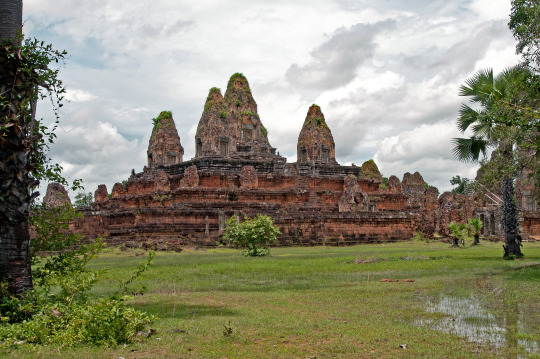
Prasat Pre Rup is a prelude temple to Angkor Wat, and often mistaken for the world famous symbol of Angkor and the Kingdom of Cambodia. The ប្រាសាទប្រែរូប- Pre Rub Temple temple was built nearly 200 years earlier. But its similar design idea and compact version of the basic structure makes it sometimes being used in photo and video presenting Angkor and Angkor Wat. It is not that strange. It takes some time to get your head around how large the newer Angkor Wat complex actually is.
The compact, unique five tower temple is today on the eastern outskirts of Angkor Thom, the great city built during the 1200s CE. Prasat Pre Rup is a hindu temple oriented North-South, and it covers an area 117 meter by 127 meter. It is constructed of brick, laterite and sandstone, and the warm, reddish colour becomes very visible during sunset and sunrise.
Temple for one of the greatest
It was the state temple of King Rajendravarman II, built just south of East Mebon Temple and 6 km east of the later Angkor Thom in 961CE. The king was one of the first true great kings of the Angkor Empire. He expanded the empire north to China, engulfing Laos and most of Thailand, and south into southern Viet Nam.
Prasat Pre Rup is built in mountain temple design with five towers, prangs, on top. They are reminiscent of the Mehru Mountain, home of the hindu pantheon of gods. Inscription in the temple mentions that the five prangs were dedicated to Shiva (central tower and one of the surrounding towers), Vishnu, Parvati (the consort of Shiva) and Lakshmi (the consort of Vishnu).
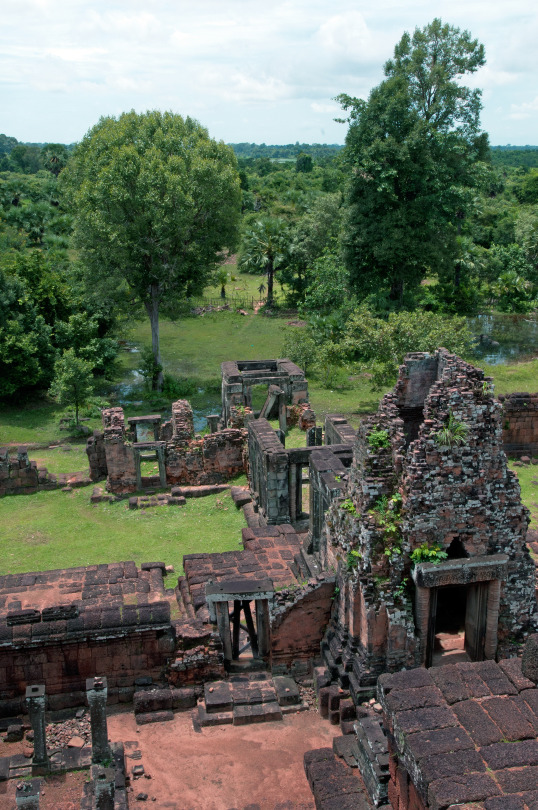
In front of the east entrance, it has three larges flower flanking on each side. On the top, you get some clean cut impressions of early Mebon Khmer style. But, you also get a fantastic outlook view of the surrounding khmer angkor culture landscape and nature.
Pre Rup is still one of my favourite sights in Angkor Archeological park.

#prasat#pre#rup#angkortemples#angkor#top5#2011CE#red#sandstone#blue#rainyseason#world#culturalheritage#architecture#art#prelude#building#world heritage site#angkor wat#angkor park
1 note
·
View note
Photo
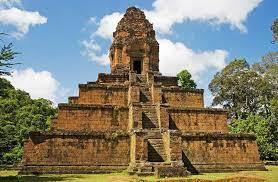
Here’s today’s travel plans, Baksei Chamkrong.
Baksei Chamkrong (Khmer: ប្រាសាទបក្សីចាំក្រុង) is a small Hindu temple located in the Angkor complex (Siem Reap, Cambodia). It is dedicated to Shiva and used to hold a golden image of him. The temple can be seen on the left side when entering Angkor Thom at the southern gate. It was dedicated to Yasovarman by his son, King Harshavarman I.[1]:114[2]:70,75 The temple was completed by Rajendravarman II (944-968).
0 notes
Photo
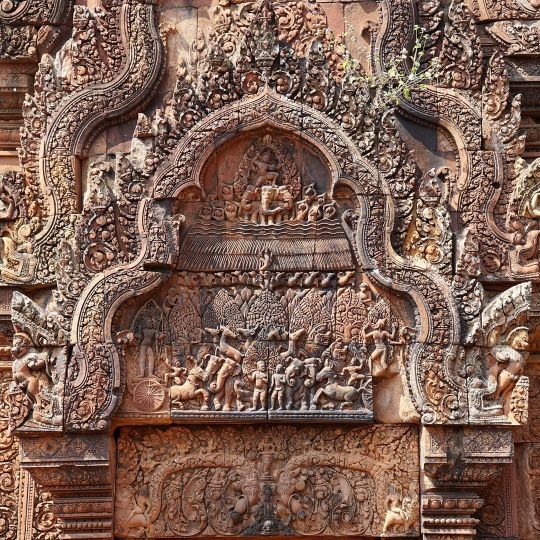
Banteay Srei - 967 CE during the reign of Rajendravarman II by Yajñavarāha - Angkor - 16 January 2023 (at Banteay Srei Temple ប្រាសាទបន្ទាយស្រី) https://www.instagram.com/p/CpUoLjvLvOu/?igshid=NGJjMDIxMWI=
0 notes
Text
Political and Spiritual history of Koh Ker
youtube
For 2 decades, At the next quarter of this century, Koh Ker rather than Angkor Virtually All monuments from the enormous Temple city - the 2nd biggest in Cambodia, next only to Angkor - Originate from this brief period.
Koh Ker Pyramid
Once Angkor Was founded
When The creator of Angkor, Yashovarman I, expired about 910 AD, he had been About him.
On the Passing of Harshavarman I, that stayed childless, his brother Ishanavarman II triumphed as his rightful heir at 922, but not without Being contested by a maternal uncle of both brothers, specifically the Neighborhood ruler in Koh Ker who afterwards became King Jayavarman IV. His chief
Koh Ker Pyramid
Construction programme at Koh Ker
Koh Ker, these Private domain until he became king. He started to construct his Own funds here in 921 and he started to execute kingly action, for example Constructing a reservoir and starting work on the tallest Khmer Temple pyramid for a royal Linga, already during the span of Ishanavarman's II principle in Angkor. This feeble king in Angkor Appears to
The erection of The most significant Shiva Linga in addition to the tallest temple pyramid hitherto Built from the Khmer empire obviously signifies that the promise to supreme power By this local ruler, even though he officially was a type of vassal of the king of Angkor.
Among the inscription The god Tribhuvanshvara. Still another, of the Exact Same date but in Khmer, Greatest god and guardian of imperial power (by most scholars Identified using a god-king because its individual form). Altogether 3 inscriptions Of Jayavarman IV boasted this structure surpassed those of previous kings.
On The departure of Ishanavarman II, that stayed childless, also, the throne now. It's not understood how the series came about. Obviously Jayavarman Had been the most effective figure in the Khmer empire for years. But It Isn't completely evident that Jayavarman IV Must be Known as a"usurpor", a person just asserting power by military Though this lonely was certainly not induce sufficient to establish his right the supreme throne.
Shortly In 928 chose to not live His construction programme. This manner Koh Ker (Chok Gargyar) substituted Angkor (Yashodharapura) as Khmer funding formally. Inscriptional evidence For Koh Ker function as capital was discovered also out Koh Ker, specifically The south. At least ten million inhabitants dwelt in the new funding.
The Reasons for this change of the funds aren't completely clarified. But, Koh Ker had begun to be an imperial endeavor and Even though it's located in a comparatively poor and inhospitable area of Cambodia, It's not much from hills Full of aluminum and iron ores, and Gold. Moreover, Koh Ker was situated in the Khmer empire chief Street from Angkor through Bang Melea into Preah Vihear and extending into Wat Phu In present-day southern Laos and eventually to the shore of central Vietnam.
IV at Koh Ker show that the temples of the city were assembled between 921 And 937, however, that many contributions were produced from approximately 928 to 932, as Many Khmer inscriptions from this period listing contributions mostly of Land and slaves into the Devaraja. State temple and also the proliferation of temples within a place of a few 35 square kilometres are evidence of their new capital's riches. As already Mentioned, virtually all them are out of the reign of Jayavarman IV, just Additions into the temples and neighboring shrines were later made by the 1 final refuge was that the hospital chapel of Prasat Andong Kuk constructed by Jayavarman VII from the late 13th century. Statues from the design of Koh Ker are notable due to their three dimensional plasticity and celebrated
Hindu temple city Koh Ker
All The monuments of Koh Ker were committed to Hindu gods, largely Shiva But maybe not to the Buddha however he had been held in high respect already during Early phases of Khmer history. Aside from Shiva, to whom many temples deities. Consecrated that refuge into Shripati (Vishnu). Inscriptions in the Door columns of Prasat Banteay Pir Chan listing that Jayavarman IV Several contributions were made for it. That is remarkable, since there Were no additional temples in Khmer history committed solely to Brahma. Prasat Bak was allegedly devoted to the worship of Ganesha.
The Sway of Jayavarman IV might have become what is currently Northeastern Thailand where many temples at the Koh Ker design have survived.
The Got the posthumous title of Pramashivapada. A slab inscription located at Prasat Bayang praises It's obsolete 941, which appears to signal That Harshavarman II was on the throne on such date, or any brief time Harshavarman II wasn't his daddy's designated heir, As an inscription relates that he"achieved kingship with the assistance of a Buddy and of the two arms". This series Appears to have been Contested, during his brief reign the king had been embroiled in continual Conflicts and among his generals needed to wage war around the town of Indrapura, which was the primary capital of the Khmer empire After just 3 years Harshavarman II Mysteriously vanished, likely he met with a violent end. Afterwards Inscriptions refer to him from the posthumous title of Brahmaloka. No Architectural accomplishments are attributed to the brief reign of Harshavarman II.
The At least at the beginning, was likely his cousin who had been the ruler of Bhavapura (at the Field of Sambor Prei Kuk) and whose mom, And of Angkor's creator Yashovarman I. just a couple of decades later with this Cousin became King Rajendravarman II, who changed the funds back to Angkor. Appears to have been valid and undisputed, although not entirely Trustworthy and unequivocal. Emphasise that Rajendravarman was greater than his predecessors. Such derogatory comparisons are extremely uncommon in Kmer inscriptions and Appears to compensate for some doubts. Another form of this settlement was The construction programme of Rajendravarman, the renewer of all Angkors
The Expedition eliminated many functions of art artwork from Koh Ker into the Musée Guimet in Paris, a few state it had been robberyothers, it had been Safeguarding, possibly both is accurate.
At The start of the 20th-century art historians identified that a different The renownd scholar for Indochina research Georges Coedès Managed to reasoned from inscriptions which Koh Ker was the Harshavarman II. French investigators at the 1930s relied fifty Sanctuaries spread over a place of 3.500 hectares (8,649 acres). Vietnam's Cham temples and affirmed that the preservation of Angkor Wat, Created educational drawings in Koh Ker.
After NASA satellite study results had been released, the secure area Of Koh Ker has been expanded to 80 square kilometres in 2004. Over 180 Monuments are known now, but a number not researched on the ground
0 notes
Photo
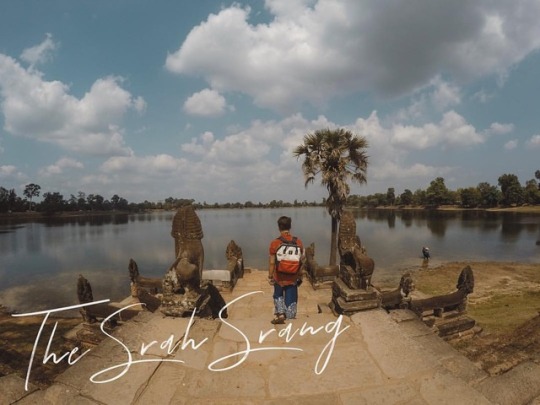
|| The Srah Srang also known as “The Royal Bathing Pool”. The Pond was dug out during the reign of King Rajendravarman II in the 10th century. It was an Ablution pool, a pond used for Ritual Washings. || 🇰🇭🇰🇭🇰🇭 #WheninCambodia2018 #SeimReap #TravelMore #TravelisLife #TreatUrSelf #Vacay102
0 notes